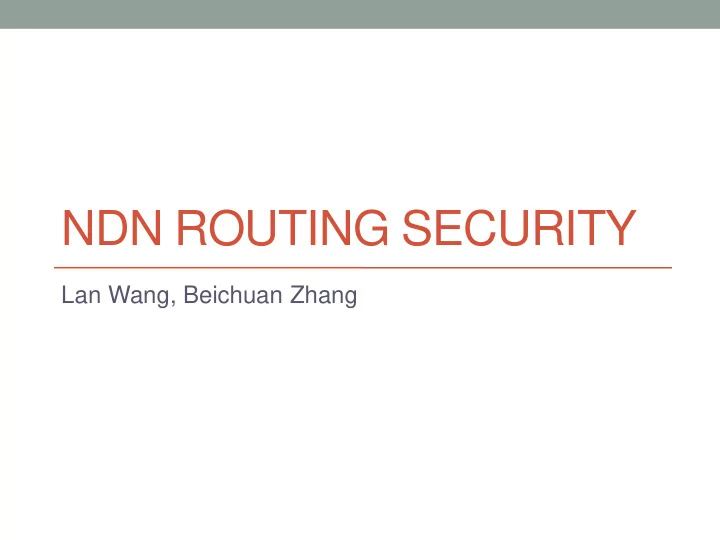

NDN ROUTING SECURITY Lan Wang, Beichuan Zhang
2/9/2015 www.named-data.net 2 Routing Security Required: authenticity and integrity of routing information o Link state routing: LSAs are originated by the routing process authorized to do so and have not been modified. o Hyperbolic routing: hyperbolic coordinates are coordinates for the associated nodes and prefixes Not required: confidentiality of routing information Solution: routing data is signed by originating router and verified by receivers based on trust model.
2/9/2015 www.named-data.net 3 Example: NLSR Trust Model [1] NLSR’s trust model follows network management structure in a single network. o The entire network has a root key, the trust anchor (pre-configured at every router). [1] AKM M. Hoque, S. O. Amin, A. Alyyan, B. Zhang, L. Zhang, and L. Wang. NLSR: Named-data link state routing protocol . In ACM SIGCOMM ICN Workshop, 2013.
2/9/2015 www.named-data.net 4
2/9/2015 www.named-data.net 5
2/9/2015 www.named-data.net 6 Signing and Verification sign verify Entity Name Root key /<network>/key Site key /<network>/<site>/key Operator key /<network>/<site>/<operator>/key Router key /<network>/<site>/<router>/key NLSR key /<network>/<site>/<router>/NLSR/key Data /<network>/NLSR/LSA/<site>/<router>/<type>/<ver>
2/9/2015 www.named-data.net 7 NLSR Security Configuration security … { rule validator { { ... id "NSLR Hierarchical Rule" rule for data { filter id "NSLR LSA Rule" { for data type name filter regex ^[^<KEY>]*<KEY><ksk-.*><ID-CERT><>$ { } type name checker regex ^[^<NLSR><LSA>]*<NLSR><LSA> { } type hierarchical checker sig-type rsa-sha256 { } type customized } sig-type rsa-sha256 key-locator trust-anchor { { type name type file hyper-relation file-name "root.cert" { } k-regex ^([^<KEY><NLSR>]*)<NLSR><KEY><ksk-.*><ID-CERT>$ } k-expand \\1 ; cert-to-publish "site.cert" ; optional, containing the site certificate. h-relation equal ; cert-to-publish "operator.cert" ; optional, containing the operator cert. p-regex ^([^<NLSR><LSA>]*)<NLSR><LSA>(<>*)<><><>$ cert-to-publish "router.cert" ; a file containing the router certificate. p-expand \\1\\2 } } } } }
2/9/2015 www.named-data.net 8 Issues in NLSR Security Implementation (1) Key generation and signing. o Whenever NLSR starts, it creates a new NLSR key. o NLSR signs the key using the router key. • what entity should have the authority to use the router key? A special launch process? Verification o Problem: timestamp of a received certificate may be later than the router’s time (due to clock difference), which causes the router to drop the key and certificate o Current solution: when signing a key, the timestamp on the certificate is earlier than the actual clock time o Is this the right solution?
2/9/2015 www.named-data.net 9 Issues in NLSR Security Implementation (2) NLSR key rollover o When NLSR restarts, it generates a new key. How do other routers know that from now on this key should be used rather than the previous key? Key revocation: an NLSR key (or router key etc.) is compromised and a new key needs to be used o Previous NLSR version used ChronoSync to distribute key names, which could solve this problem (and the previous one), but was taken out when new Validator was put in.
2/9/2015 www.named-data.net 10 Issues in NLSR Security Implementation (3) Key retrieval and key name o key is retrieved after NLSR Data packet is received (if the key has not been retrieved) o Currently Interests for keys are broadcast (no FIB entries for the keys until routing table is built) o Below are alternatives: • use ChronoSync to distribute key names: the keys still need to have a broadcast prefix since ChronoSync doesn’t actually send the keys in its data packets (unless ChronoSync always piggybacks the keys in its data packets). • append key to data packet when a node replies with NLSR data: requires composite packet format, but makes the packet bigger than necessary if the receiver already has the key • sends Interest for key to the neighbor that previously replied with the NLSR data: requires NLSR to know which face the data came in and send key Interest to that face
Recommend
More recommend